As an Amazon Associate I earn from qualifying purchases.
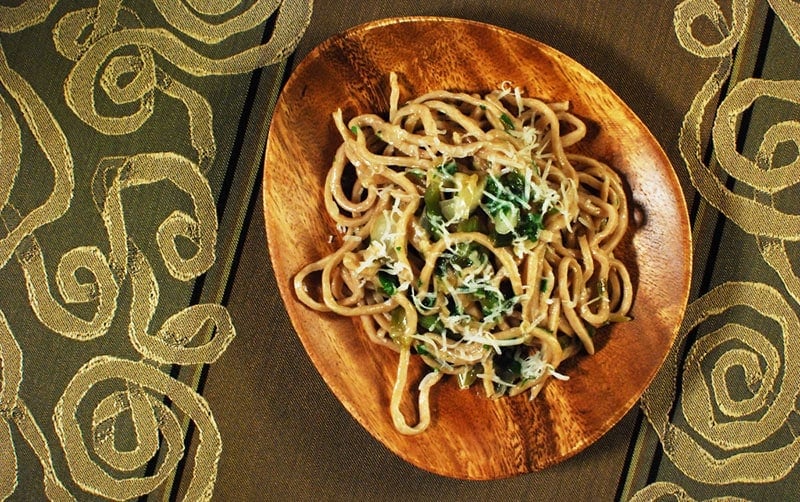
Making pasta is, for me, therapeutic. There is a zen in noodle-making that I am certain Asian noodle makers understand, and it definitely translates into Italian pasta. Good pasta requires an outside awareness of what is not obvious: A feeling about whether there is too much water in the dough or not enough, an inkling that the dough has been kneaded enough.
Making spaghetti alla chitarra is less zen and more rock and roll, however.
A chitarra is an odd wooden contraption we think originated in Abruzzi, in central Italy on the Adriatic side of the peninsula. Meaning ‘guitar,’ a chitarra looks like a double-sided harp, with strings set close on one side, farther on the other. In then center of the device is a slanted board, designed to allow the cut pasta to slide off easily once it’s been cut by the strings.
I’ve never been too sure about why a chitarra was exactly necessary. The wide side is basically tagliatelle, which are easily cut by hand. The narrower side makes more sense because hand-cut spaghetti are trickier. This is probably why people normally make spaghetti alla chitarra, not other chitarra pasta.
I began reading about chitarra pasta, and, best I can tell, no one can really determine how thick the noodles ought to be. The Encyclopedia of Pasta says roll the dough out “not too thin,” and that ‘s about the best advice I can give: Spaghetti alla chitarra is not delicate, except for a rare version where the wires are spaced so thin they make angel hair pasta.
I decided to make a square spaghetti, which meant rolling out the dough to No. 2 on my Atlas machine — pretty thick. As for the chitarra itself, you can buy one online, or buy a chitarra attachment for your Atlas. Gotta say though, “playing the chitarra” was way more fun than cranking a machine handle.
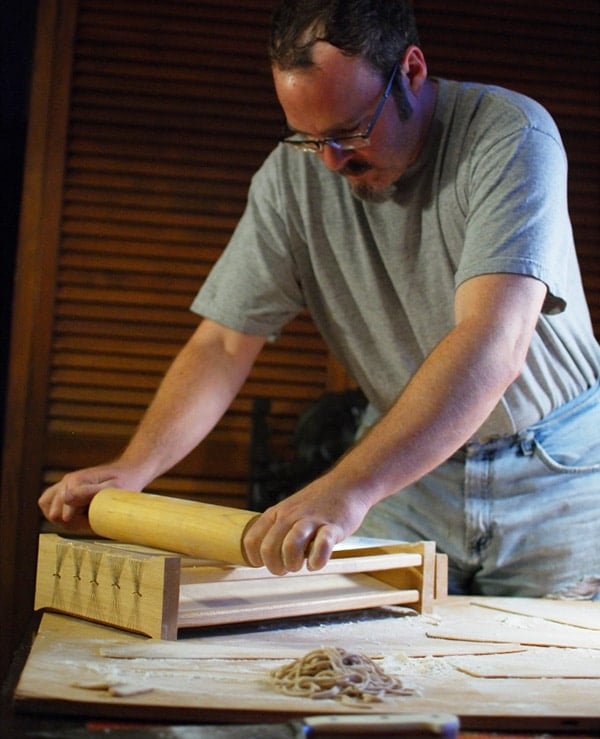
When you dislodge the pasta from the machine, you literally play the strings, and the vibration knocks the noodles onto the slanted board. Dust them with plenty of flour immediately so they don’t stick together.
What dough to use? Well, as some of you know, I am a huge fan of alternate flours: whole wheat, chestnut, rye, barley, spelt, even chickpea and acorn. I love the flavor of farro, also known as emmer: It is one of the oldest known varieties of cultivated wheat, and eating it — whole like a risotto, or ground into flour — makes you understand why, 10,000 years ago, humans decided to settle down and try to grow more of this amazing stuff. Farro is to typical whole wheat flour what supermarket baloney is to real mortadella.
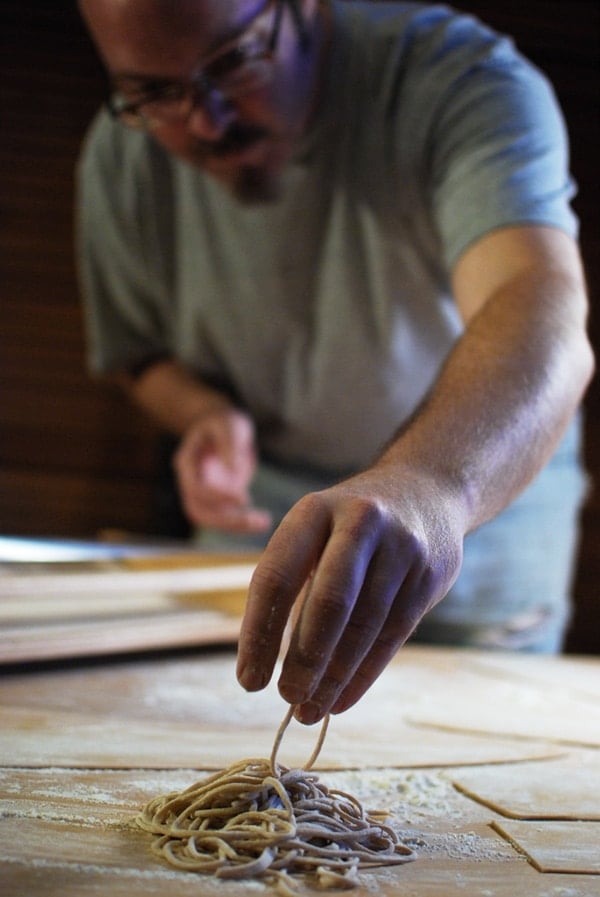
Doughs are idiosyncratic. The use of eggs is always optional, but they add strength and flavor and, if you’re using yolks, color. I like the coffee-with-cream look of a straight farro pasta, but I had the whites of several duck eggs lying around (I used the yolks to make my oregano ice cream for an upcoming dinner party). So I used them in the pasta dough.
I like the idea, but the dough turned out too wet, so I ended up adding a fair bit of regular flour as I kneaded the dough — for a full 10 minutes, as farro is a tough grain. I let it set for two hours so the farro could absorb all the liquid, and went to work.
I had originally planned to serve this farro spaghetti alla chitarra with a puree of cardoons stewed with leeks, but the cardoons turn to water when I tried, so I left them out and just used the leeks. Worked for me, and made a great winter-into-spring dish — a little hearty, a little sprightly.
Maybe I was overstating it a bit when I said making spaghetti alla chitarra lacks the calming power of making other kinds. That’s not true. I felt better making something with my hands.
And honestly, playing crazy anarchist harp player while strumming the chitarra made Holly and I both laugh. A lot.
Spaghetti alla Chitarra
Ingredients
- 10 ounces whole wheat, farro, spelt or einkorn flour about 1 1/2 cups
- 3 ounces all-purpose flour, about 1/2 cup
- 1 teaspoon olive oil
- Whites from 4 eggs
- 2 tablespoons water
Instructions
- Whisk together flours and pour into a large bowl. Make a well at the center.
- Whisk together the egg whites, water and olive oil and pour into the well. Mix together by hand, and when the dough comes together begin kneading — if you suspect the dough may be too dry, add a smidge of water. Use extra flour if it is too wet.
- Knead for a good 5 to 10 minutes. Wrap in plastic and set aside to rest for 1 hour, or up to 24 hours in the fridge. One neat trick is to vacuum seal your dough, which will hydrate it instantly.
- To make spaghetti alla chitarra, you want to roll out your dough to about 1/8" thick, either with a rolling pin or with a pasta maker. If you do it with a pasta maker, it will only need to be passed through to the No. 2 setting, which is fairly thick. Make sheets of dough about as long as you want your spaghetti to be.
- Lay the dough sheet on your chitarra, then use a rolling pin to roll the dough through wires. Some will stick, so you "play the guitar" by strumming the wires, which releases the pasta. Dust it in a little all-purpose flour and set aside until ready to cook.
Notes
Nutrition
Nutrition information is automatically calculated, so should only be used as an approximation.
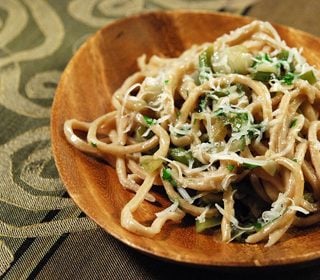
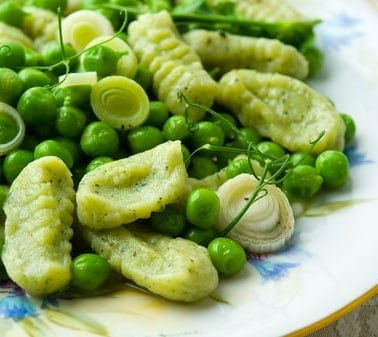
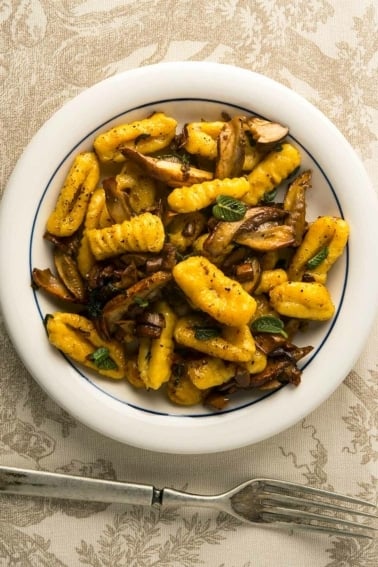
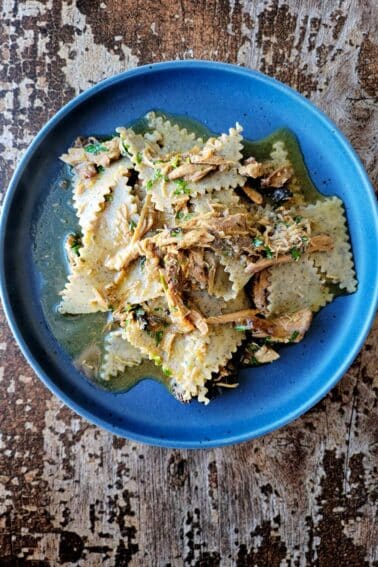
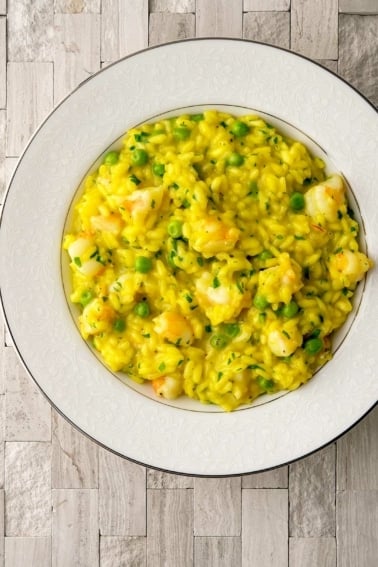
Hey Hank
You don´t know, how long I´ve been looking for this recipe – thank you very much! I was in Abruzzo a couple of years ago and was lucky enough to receive an invitation for dinner at a friends house and his mother served a dish made of pasta Chitarra-fashion. I loved it and since then I´ve been wondering how it´s made – I simply have to try it myself! So thank u very much for that!
I’ve never seen this much passion in making pasta before. I know I’ve read plenty of pasta making articles but quite a few gave details like yours did. I would definitely want to get a hold of a chitarra and see what kinds of pasta I could make from it. Though I’ve always had this experience where manually doing things is much easier than doing the machines, but hey, I need a laugh too 🙂
Received a chitarra from family in Giulianova this summer. My husband had researched his family in Italy and we had a 1st meeting/reunion this July in Giulianova. The Italian’s repeatedly said they’ve been waiting nearly 70 years for an American Giorgini to come home…. Beyond fantastic trip. During our first meal there – we had pasta alla chitarra, and I was over the moon about the pasta. The family presented me with my own chitarra before we flew out. (had to scramble w/ the RyanAir carry-on restrictions, but it was worth it!!)
I’m using it for the first time this weekend and I sure appreciated the advice on the dough from this site. – grazie mille
Judith: All good stuff to know. I am working on getting good enough to roll out translucent pasta by hand… Looking forward to seeing you in Portland!
Congrats & Auguri on the Beard & IACP nomination! Bravo!
I live in Umbria most of the year and use and love my chitarra all the time. Pasta thickness is strictly a matter of personal taste/preference. There are no pasta-thickness police that I know of! I like it as thin as possible, so I can see the grain of my marble table when I roll it out (much quicker than the Atlas, IMHO).
Strangozzi or strangoprezzi (strangle the priest…who’s says the Italians don’t have a sense of humor about religion?) isn’t made on a chitarra. It’s another cutting device, but it’s all a variation on a theme.
A good torchio is hard to come by… absolutely look for brass dies and get one with a seat because you’ll need it. Email if you want some more info. Or… we can talk in Portland!
JA: I like black breads, actually. Great with lots of butter. As for the chitarra, I’ve been fascinated with them for years, but only bought one recently. Gotta say it’s more of a toy than anything, as I can hand-cut noodles pretty well without it.
Karen and Dawn: Tell me about it. Laughter is the best medicine…
Tovar: I often do the same thing, but if you are not careful the pasta will snap when you take it off the clothes dryer.
Kate: Those were probably hand-cut, or made with a torchio, which is a Renaissance-era pasta device I need to buy. It extrudes pasta with a ratchet action, and unless your dough is VERY strong, it’ll create those warped shapes, which actually catch sauce better.
Carol: I thought the same thing. They do look like soba. Don’t have a recipe, but I bet I could find one…
Great post! I love my chitarra, too. The square shape of your pasta, and its color, reminded me of Japanese soba noodles, made with buckwheat. Have you ever made those, and do you have a recipe? I’m now inspired to try! With the warm weather we’ve been having in L.A., cold soba with dipping sauce sounds awfully good…
Looks awesome, Hank. Glad to see you back on your feet after such recent hard knocks. Your noodles resemble the strangozzi (also sometimes spelled stringozzi) of central Umbria. They are thick, ropey, and substantive, apparently/possibly referencing the garrote in both form and name. They were definitely square-cut noodles. But all the strangozzi I was ever served were just slightly irregular and twisted, so I guess they weren’t made with a chitarra. Usually they were sauced with a tomato-cinghiale concoction.
Great post and pics, Hank and Holly.
We made pasta a few weeks ago, when my stepson and his wife were visiting. We sliced it fettucini-width and had it hanging over the bars of a clothes drying rack between the dining table and the kitchen. It felt just a tiny bit like an old-world kitchen in the village where Catherine’s grandmother grew up, in the hill country inland from Naples.
Laughter. Nothin’ better. I like the fact that Holly has included you in some of the photos, Hank. My friends always ask me why I’m never in my blog pics… it’s because I’m always the one behind the camera!
Using a chitarra must be like making music and making pasta at the same time and what could be better than that!. Great photos!
Interesting – didn’t know about a Chitarra “harp” pasta maker before this post. Actually sounds like fun to do.
Holly did it again with the placemat swirls matching the curls of the pasta! Also love the perspective in last photo emphasizing your hand placing the pasta on the plate.
Reading your blog and seeing Holly’s photos are a real treat!
Lanesville Lady: ding ding ding ding ding! You nailed it!
The funny thing is that Hank noticed yesterday that I’ve put out that cloth for pasta many times before, which I hadn’t realized. But this is the first time we noticed how well it matched the pasta. There’s something about this pasta in particular that really goes well with the slightly rough curves of the cloth design.
You constantly amaze me with your ability to find new (to me anyways) processes and tools. Research pays off, right?
I have been playing with different flours recently as I attempt to make lighter whole grain breads. My latest adventure with a high percentage of spelt, led to an almost black loaf that had some fantastic flavor going on. One day I’ll try my hand at making pasta…